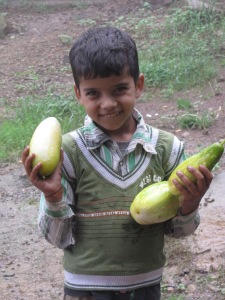It has been monsoon times in Naddi. Through September, the drops of water did not stop, and had cut the sun’s time to shine to 5 minutes every once in a while. Rainbows did not miss that opportunity to show up and add up to the already colorful village in the Himalayas.
Rainbows sneak in when rains stop for a minute
Clouds came and went around the surrounding mountains: sometimes a small cloud sat in between the hills, like a giant marshmallow, while some other times, these gas formations managed to hide entire mountains. Humidity and moist became the daily weather forecast. Clothes got endlessly wet, umbrellas the essential accessory for the season, and at night, the outside lights from the houses magically lit up the mist.
Organic farming
 India depends on the monsoon to feed its ever-growing population, that reaches more than 1.160 million people now. While most of the country is dry and hot the rest of the year, non-stop monsoon rains through June to September provide the crops with just the right kind of climate to grow: at least 55% percent of India’s land depends on these rains, due to the lack of irrigation systems.
India depends on the monsoon to feed its ever-growing population, that reaches more than 1.160 million people now. While most of the country is dry and hot the rest of the year, non-stop monsoon rains through June to September provide the crops with just the right kind of climate to grow: at least 55% percent of India’s land depends on these rains, due to the lack of irrigation systems.
Local organic cucumbers and beans
And although this year’s monsoon India had suffered from lack of rains in the initial phase but caught up so,me of the deficits in September. The late rain lead to difficulties for the population that saw how their crops withered before growing.
Initiatives like our kitchen organic farms aim to help sustaining villagers food production capacities. The motto is simple: why buying vegetables at the shop if you can grow your own? The first cucumbers, beans, carrots and pumpkins have grown and have been enjoyed by our community.
Bobby holds the first vegetables from the organic farm


